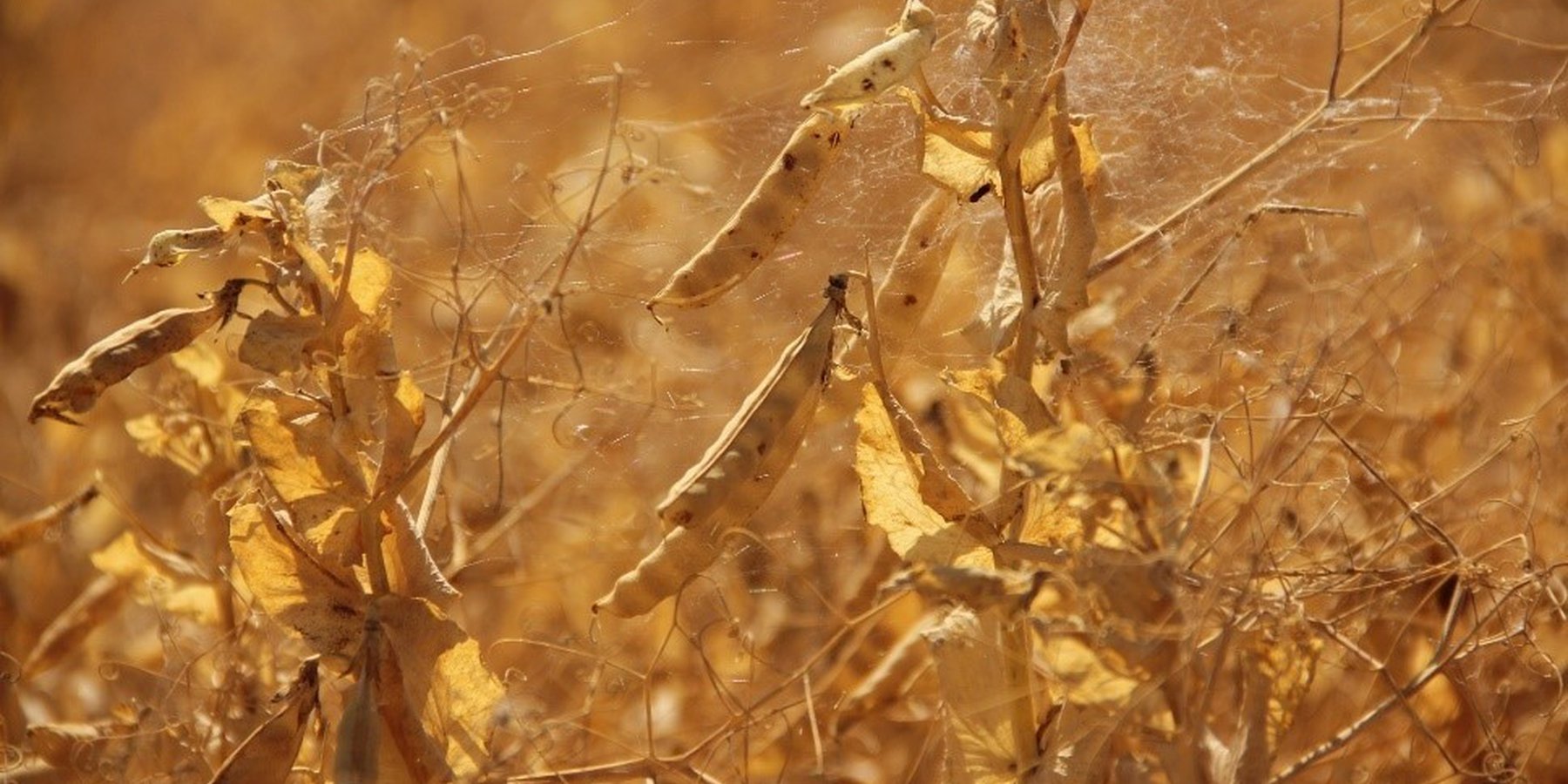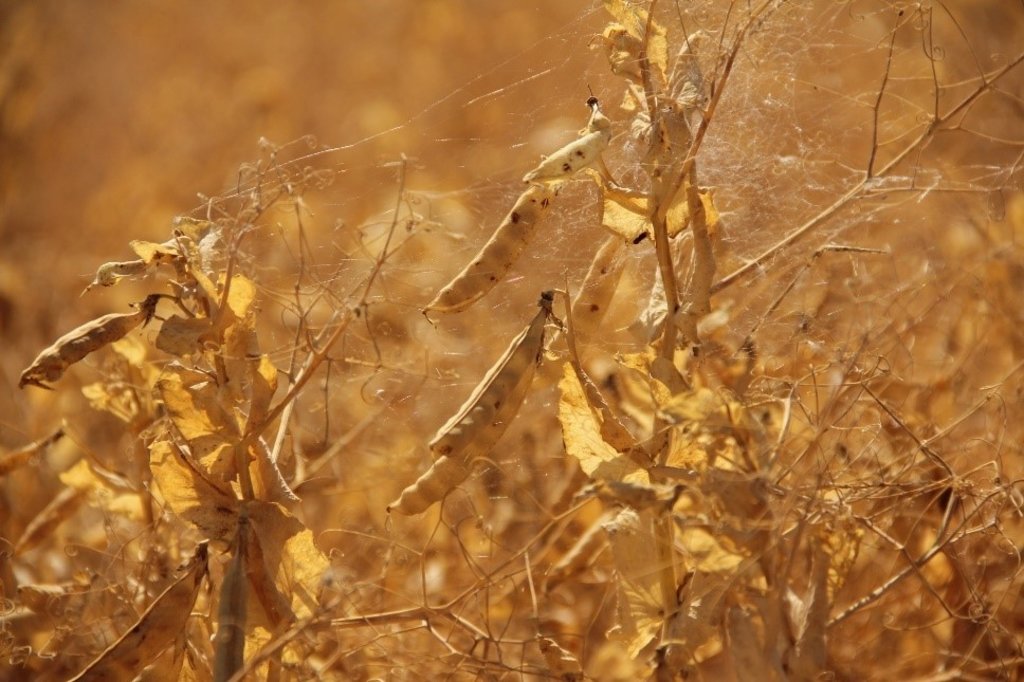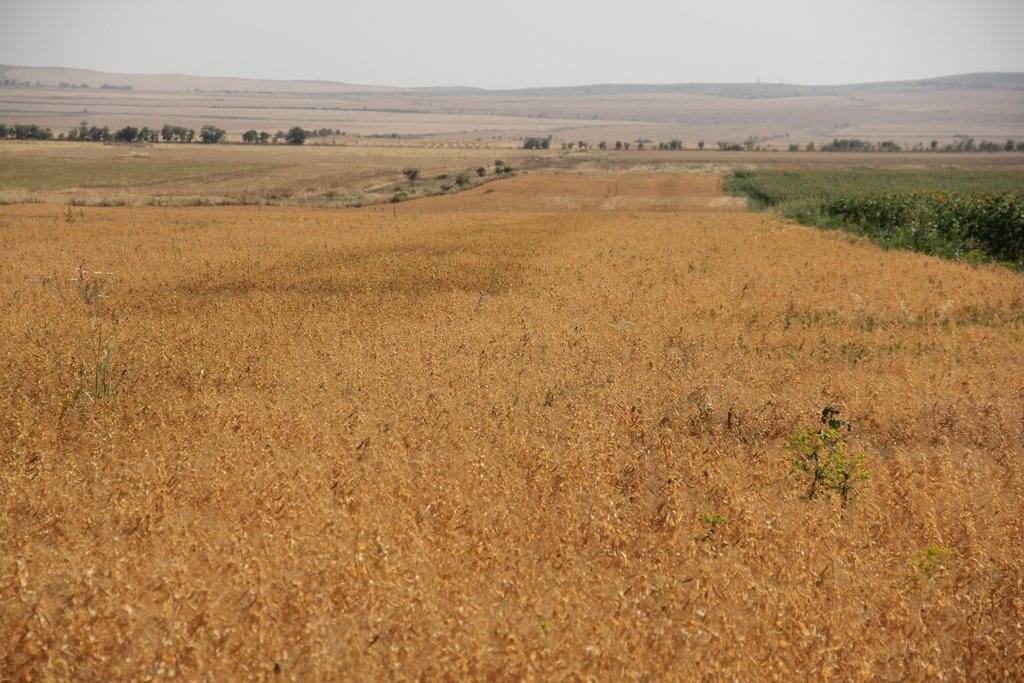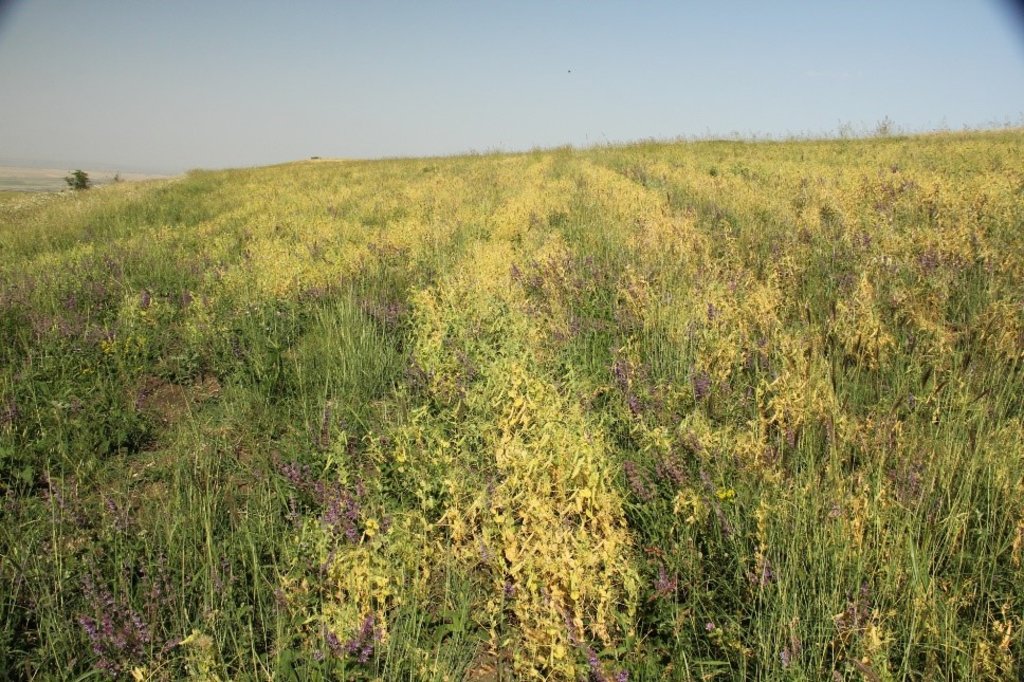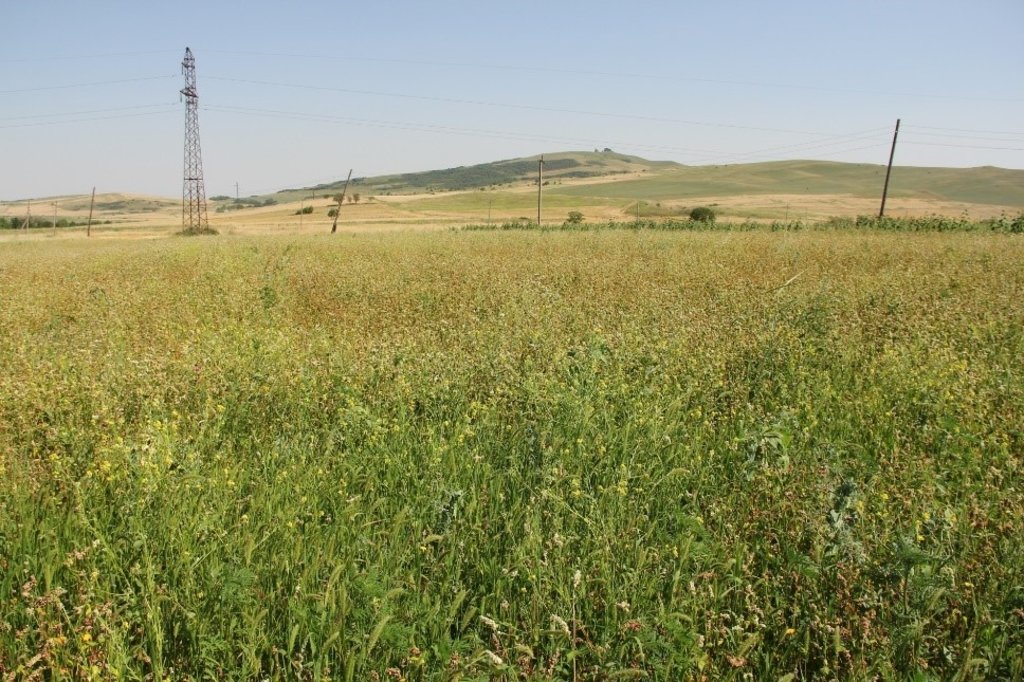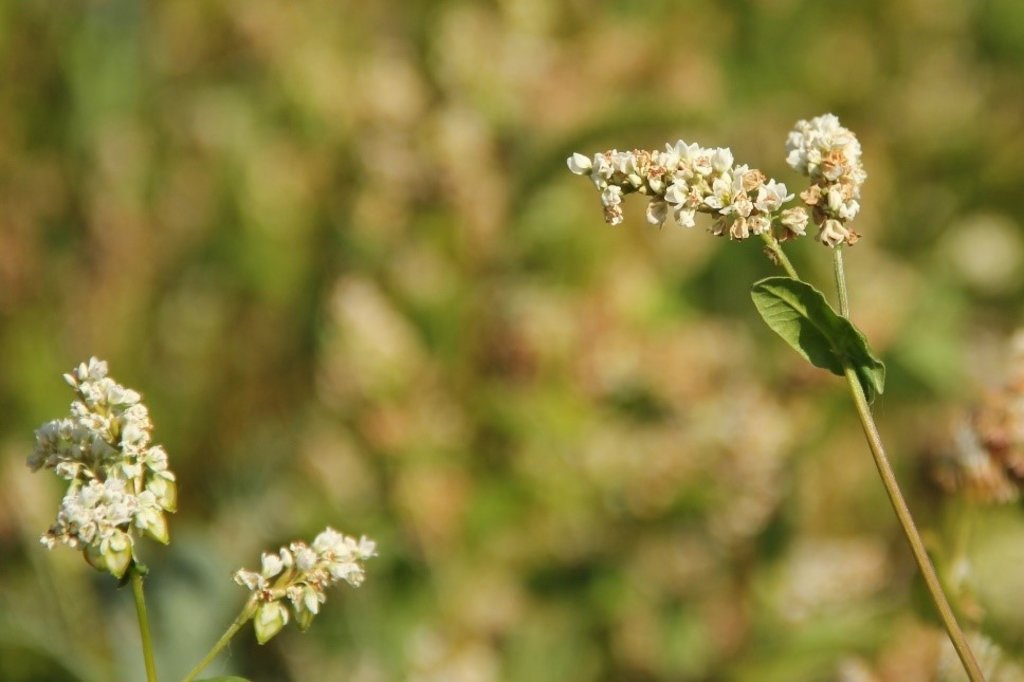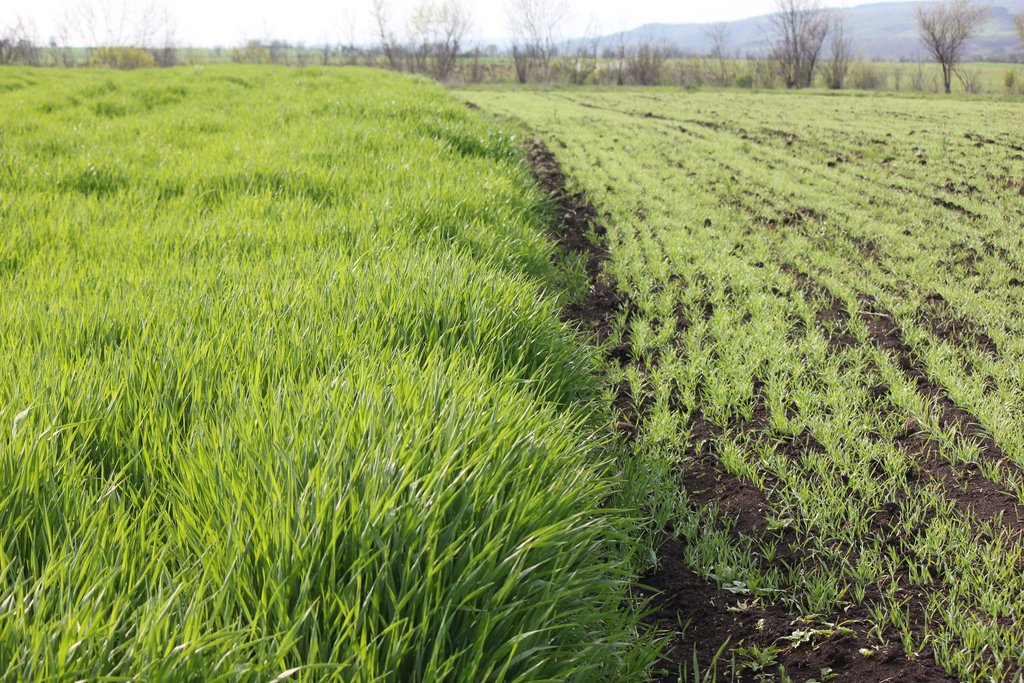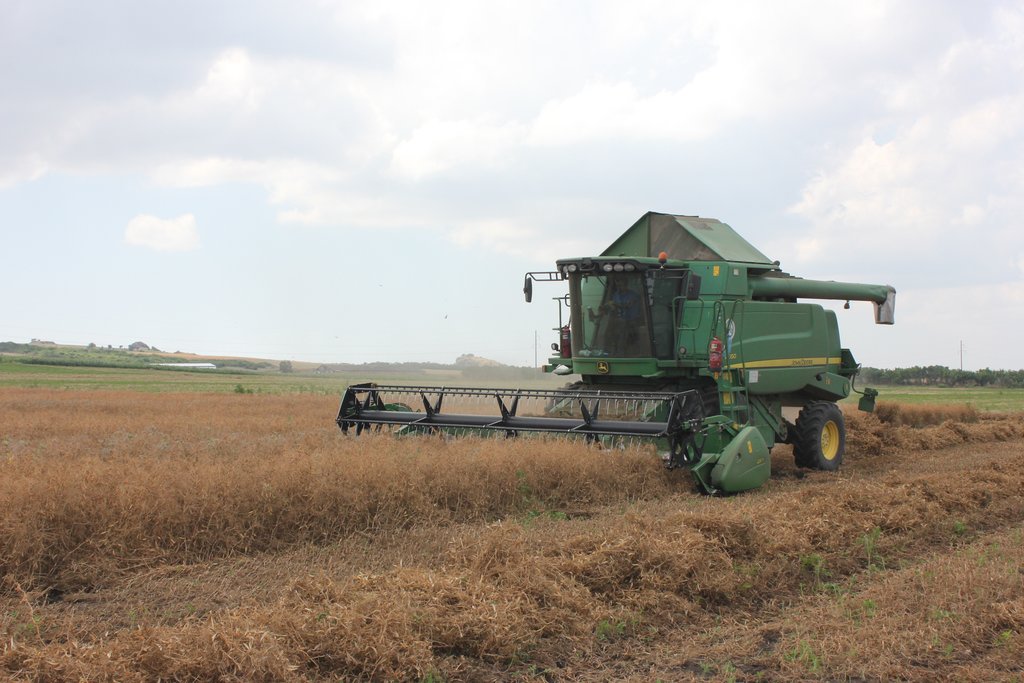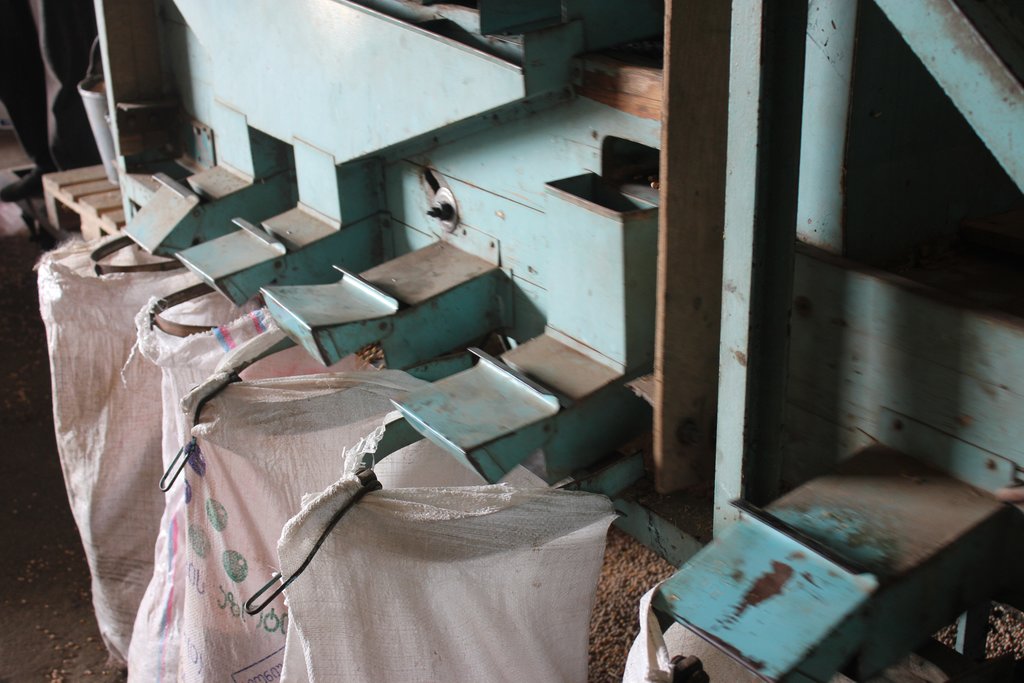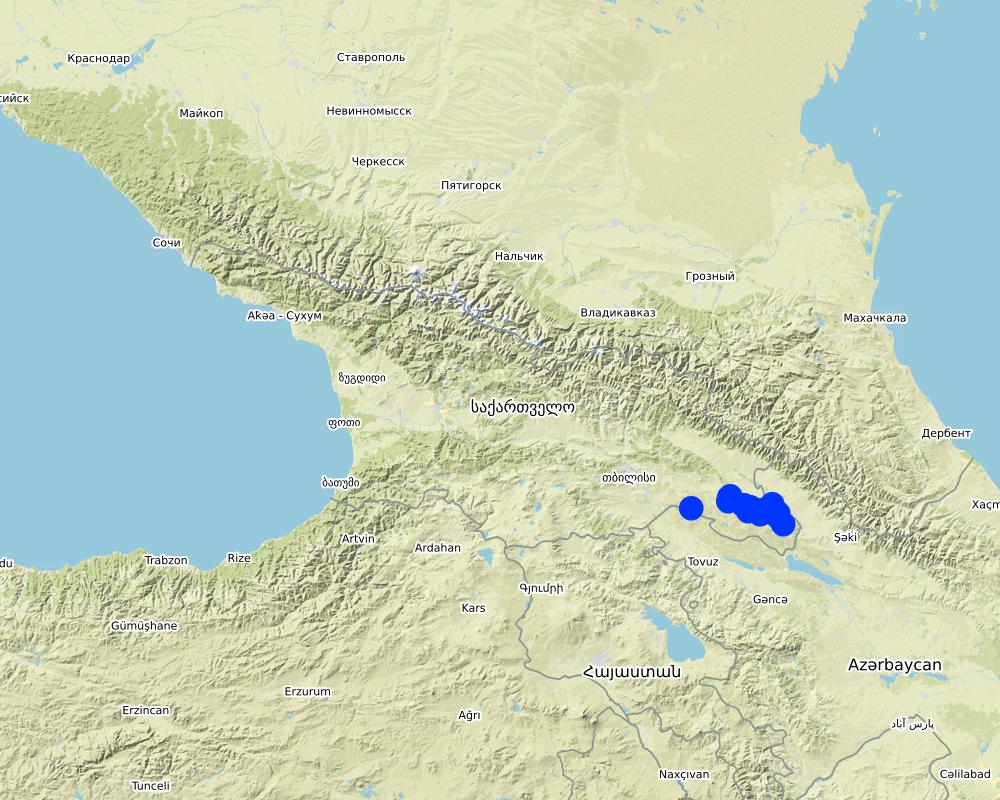Introduction of Crop Rotation [乔治亚]
- 创建:
- 更新:
- 编制者: Hanns Kirchmeir
- 编辑者: Kety Tsereteli
- 审查者: Ursula Gaemperli
technologies_4275 - 乔治亚
查看章节
全部展开 全部收起1. 一般信息
1.2 参与该技术评估和文件编制的资源人员和机构的联系方式
co-compiler:
有助于对技术进行记录/评估的项目名称(如相关)
Applying Landscape and Sustainable Land Management (L-SLM) for mitigating land degradation and contributing to poverty reduction in rural area (L-SLM Project)有助于对技术进行记录/评估的机构名称(如相关)
Regional Environmental Centre for the Caucasus (REC Caucasus) - 乔治亚1.3 关于使用通过WOCAT记录的数据的条件
编制者和关键资源人员接受有关使用通过WOCAT记录数据的条件。:
是
1.4 所述技术的可持续性声明
这里所描述的技术在土地退化方面是否存在问题,导致无法被认为是一种可持续的土地管理技术?:
否
2. SLM技术的说明
2.1 技术简介
技术定义:
In the municipality of Dedoplistskaro, Georgia, 100 ha of land have been cultivated with peas on approx. 25 fields (each 1-10 ha in size). The introduction of peas as an alternative crop that is now used in rotation with wheat, helps to increase soil fertility sustainable and ecologically.
2.2 技术的详细说明
说明:
Dedoplistskaro is located in the Shiraki Plain, in eastern Georgia, and consists of steppes, where grain crops are cultivated and livestock is grazed in the winter. The steppic soils are dominated by Chernozems and Kastanozems, the climate is warm and temperate and the small-scale land (2-5 ha) is in individual ownership. The labour including plowing, seeding and harvesting is fully mechanised, the machines are mainly borrowed from agricultural machinery cooperatives and less often from private machinery suppliers. For the inhabitants of Dedoplistskaro municipality, agricultural production is an important source of income. 74% of the Georgian wheat production is located in the Kakheti region. Shiraki valley has a great share of this. The area of wheat production in Dedoplistskaro is 13,693 ha (Census 2014). Securing the productivity of arable land and stopping degradation due to the loss of soil fertility is of local and national importance. The introduction of pea as an alternative crop, which can be used in rotation with wheat or other crops, should help to increase soil fertility in a sustainable and ecologically viable way. Pea is a plant from the legume plant family. The root system of Pea can thus fix nitrogen from air by symbiotic bacteria. This helps to increase the C/N ratio in the soil leading to higher decay rates of organic carbon (e.g. from straw residuals) and higher fertility of soils. Most farmers sowed on 23 and 24 March 2018 - some until 29 March 2018. Later sowing led to lower yields.
2.3 技术照片
2.5 已应用该技术的、本评估所涵盖的国家/地区/地点
国家:
乔治亚
区域/州/省:
Kakheti
有关地点的进一步说明:
Dedoplistskaro
具体说明该技术的分布:
- 均匀地分布在一个区域
如果技术均匀分布在一个区域,则指定覆盖的区域(单位为平方千米):
1.0
技术现场是否位于永久保护区?:
否
Map
×2.6 实施日期
注明实施年份:
2018
2.7 技术介绍
详细说明该技术是如何引入的:
- 通过项目/外部干预
3. SLM技术的分类
3.1 该技术的主要目的
- 改良生产
- 减少、预防、恢复土地退化
- 创造有益的经济影响
3.2 应用该技术的当前土地利用类型
同一土地单元内混合使用的土地::
否

农田
- 一年一作
年作 - 具体指明作物:
- 谷类 - 小麦(春季)
- 豆科牧草和豆类 - 豌豆
- buckwheat
每年的生长季节数:
- 1
采用间作制度了吗?:
否
采用轮作制度了吗?:
是
如果是,请具体说明:
Crop rotations with wheat, pea and buckwheat. Different systems, one example: Year 1: Wheat, Year 2: Pea, Year 3: Wheat, Year 4: Wheat, Year 5: Buckwheat, Year 6: Wheat, Year 7: Wheat, Year 8: Pea, Year 9: Wheat
注释:
Before the implementation of the technology wheat was cultivated without intercropping or crop rotation.
3.3 由于技术的实施,土地使用是否发生了变化?
由于技术的实施,土地使用是否发生了变化?:
- 是(请在技术实施前填写以下有关土地利用的问题)
同一土地单元内混合使用的土地::
否

农田
- 一年一作
年作 - 具体指明作物:
- 谷类 - 小麦(春季)
采用轮作制度了吗?:
否
注释:
It is envisaged to continue with crop rotation in the following years.
3.4 供水
该技术所应用土地的供水:
- 雨养
3.5 该技术所属的SLM组
- 轮作制度(轮作、休耕、轮垦)
3.6 包含该技术的可持续土地管理措施

农艺措施
- A2:有机质/土壤肥力
注释:
The nitrogen fixing capabilities of the pea-roots will increase fertility of the soil additionally to the crop-rotation effect.
3.7 该技术强调的主要土地退化类型

化学性土壤退化
- Cn:肥力下降和有机质含量下降(非侵蚀所致)
注释:
The permanent cultivation of wheat on the same field leads to degradation of fertility.
3.8 防止、减少或恢复土地退化
具体数量名该技术与土地退化有关的目标:
- 防止土地退化
- 减少土地退化
注释:
The crop rotation will reduce and/or prevent from land degradation by permanent wheat cultivation.
4. 技术规范、实施活动、投入和成本
4.1 该技术的技术图纸
技术规范(与技术图纸相关):
Proposed rotation schema for wheat, pea and buckwheat
作者:
Hanns Kirchmeir
日期:
07/02/2018
4.2 有关投入和成本计算的一般信息
具体说明成本和投入是如何计算的:
- 每个技术区域
注明尺寸和面积单位:
100 ha
具体说明成本计算所用货币:
- 美元
注明雇用劳工的每日平均工资成本:
20
4.3 技术建立活动
| 活动 | 时间(季度) | |
|---|---|---|
| 1. | Selection of farmers and fields according to the selection schema and signed subsidy contracts to all farmers | Until January 2018 |
| 2. | Scientific assessment of soil fertility before seeding | October 2017-Novembver 2018 |
| 3. | Seeding, maintaining and harvesting | March-October 2018 |
| 4. | Scientific assessment of soil fertility before seeding | October 2018 |
4.4 技术建立所需要的费用和投入
| 对投入进行具体说明 | 单位 | 数量 | 单位成本 | 每项投入的总成本 | 土地使用者承担的成本% | |
|---|---|---|---|---|---|---|
| 劳动力 | plowing | ha | 100.0 | 35.71 | 3571.0 | 40.0 |
| 劳动力 | harrowing | ha | 100.0 | 14.29 | 1429.0 | 40.0 |
| 劳动力 | seeding | ha | 100.0 | 8.93 | 893.0 | 40.0 |
| 劳动力 | harvesting | ha | 100.0 | 35.71 | 3571.0 | 40.0 |
| 植物材料 | pea-seeds (250kg) | ha | 100.0 | 133.93 | 13393.0 | 40.0 |
| 肥料和杀菌剂 | herbicide (1l) | ha | 100.0 | 5.36 | 536.0 | 40.0 |
| 技术建立所需总成本 | 23393.0 | |||||
| 技术建立总成本,美元 | 23393.0 | |||||
如果土地使用者负担的费用少于100%,请注明由谁负担其余费用:
60% of the cost have been added as a subsidy payed from GEF project funds.
注释:
The funding was organised in a public call. Farmers from the Dedoplitskaro region have been invited to apply for a 60% co funding of the pea/buckwheat planting.
The costs stated in the section "Labour" for plowing, harrowing, seeding and harvesting include costs for labour and for equipment. The work was done partly by the farmers themselves and partly by an agricultural contractor such as for driving the harvester. The machines are mainly borrowed from a local machinery cooperative, but also from private machinery suppliers.
4.5 维护/经常性活动
注释:
The full production cycle (plowing, harrowing, seeding, harvesting including the application of pesticide have been included in the 'establishment' section.
4.6 维护/经常性活动所需要的费用和投入(每年)
注释:
The full production cycle (plowing, harrowing, seeding, harvesting including the application of pesticide have been included in the 'establishment' section.
4.7 影响成本的最重要因素
描述影响成本的最决定性因素:
It was a challenge to organised the high amount of pea-seeds, as they are not commonly available in the region.
5. 自然和人文环境
5.1 气候
年降雨量
- < 250毫米
- 251-500毫米
- 501-750毫米
- 751-1,000毫米
- 1,001-1,500毫米
- 1,501-2,000毫米
- 2,001-3,000毫米
- 3,001-4,000毫米
- > 4,000毫米
指定年平均降雨量(若已知),单位为mm:
697.00
有关降雨的规范/注释:
The driest month is January, with 25 mm of rainfall. The greatest amount of precipitation occurs in June, with an average of 108 mm. The difference in precipitation between the driest month and the wettest month is 83 mm.
注明所考虑的参考气象站名称:
Dedoplistskaro Met. Station
农业气候带
- 半干旱
The climate is warm and temperate in Dedoplistskaro. The average annual temperature in Dedoplistskaro is 11.3 °C. The warmest month of the year is July, with an average temperature of 22.7 °C. The lowest average temperatures in the year occur in January, when it is around 0.1 °C.
5.2 地形
平均坡度:
- 水平(0-2%)
- 缓降(3-5%)
- 平缓(6-10%)
- 滚坡(11-15%)
- 崎岖(16-30%)
- 陡峭(31-60%)
- 非常陡峭(>60%)
地形:
- 高原/平原
- 山脊
- 山坡
- 山地斜坡
- 麓坡
- 谷底
垂直分布带:
- 0-100 m a.s.l.
- 101-500 m a.s.l.
- 501-1,000 m a.s.l.
- 1,001-1,500 m a.s.l.
- 1,501-2,000 m a.s.l.
- 2,001-2,500 m a.s.l.
- 2,501-3,000 m a.s.l.
- 3,001-4,000 m a.s.l.
- > 4,000 m a.s.l.
说明该技术是否专门应用于:
- 不相关
5.3 土壤
平均土层深度:
- 非常浅(0-20厘米)
- 浅(21-50厘米)
- 中等深度(51-80厘米)
- 深(81-120厘米)
- 非常深(> 120厘米)
土壤质地(表土):
- 细粒/重质(粘土)
土壤质地(地表以下> 20厘米):
- 细粒/重质(粘土)
表土有机质:
- 高(>3%)
如有可能,附上完整的土壤描述或具体说明可用的信息,例如土壤类型、土壤酸碱度、阳离子交换能力、氮、盐度等。:
In the region steppic soils are dominating (Chernozems and Kastanozems)
5.4 水资源可用性和质量
地下水位表:
5-50米
地表水的可用性:
匮乏/没有
水质(未处理):
不良饮用水(需要处理)
水质请参考::
地下水
水的盐度有问题吗?:
否
该区域正在发生洪水吗?:
否
5.5 生物多样性
物种多样性:
- 低
栖息地多样性:
- 低
关于生物多样性的注释和进一步规范:
The landscape is intensively used by agricultural purpose. The former network of windbreaks was massively reduced in the last decades. Re-establishing could support the habitat diversity significantly.
5.6 应用该技术的土地使用者的特征
定栖或游牧:
- 定栖的
生产系统的市场定位:
- 混合(生计/商业)
非农收入:
- 低于全部收入的10%
相对财富水平:
- 贫瘠
个人或集体:
- 个人/家庭
机械化水平:
- 机械化/电动
性别:
- 男人
土地使用者的年龄:
- 中年人
说明土地使用者的其他有关特征:
The local farmers-association was an important partner in promoting the imitative.
5.7 应用该技术的土地使用者使用的平均土地面积
- < 0.5 公顷
- 0.5-1 公顷
- 1-2 公顷
- 2-5公顷
- 5-15公顷
- 15-50公顷
- 50-100公顷
- 100-500公顷
- 500-1,000公顷
- 1,000-10,000公顷
- > 10,000公顷
这被认为是小规模、中规模还是大规模的(参照当地实际情况)?:
- 小规模的
5.8 土地所有权、土地使用权和水使用权
土地所有权:
- 个人,未命名
- 个人,有命名
土地使用权:
- 个人
用水权:
- 自由进入(无组织)
土地使用权是否基于传统的法律制度?:
否
5.9 进入服务和基础设施的通道
健康:
- 贫瘠
- 适度的
- 好
技术援助:
- 贫瘠
- 适度的
- 好
就业(例如非农):
- 贫瘠
- 适度的
- 好
市场:
- 贫瘠
- 适度的
- 好
能源:
- 贫瘠
- 适度的
- 好
道路和交通:
- 贫瘠
- 适度的
- 好
饮用水和卫生设施:
- 贫瘠
- 适度的
- 好
金融服务:
- 贫瘠
- 适度的
- 好
6. 影响和结论性说明
6.1 该技术的现场影响
社会经济效应
生产
作物生产
注释/具体说明:
The average yield of peas 3 t/ha, 98 t pea yield was taken from the pilot plots. Some of the farmers will sow the peas in other plots to improve soil fertility on another land under their ownership. Buckwheat was sown only on 2 plots, 450 kg at all. The farmers who had opted for the concept of starting the crop rotation with buckwheat cultivated the green mass in the soil to improve their fertility. The harvest of peas/buckwheat was very variable between the different farmers depending on their timing of measures: 1. The farmers who could not use the possibility to seed the crops in March - 1 farmer, because of rainy weathers afterwards, seeded pea later , in the middle of April. This farmer could not get yield from the plot. The others (2-3 farmers) who could not harrow the soil after seeding (as we recommended to harrow), they got the small yield.
对现场影响的评估(测量)进行具体说明:
When peas are used as a intercrop between winter wheat cultivation, this would have a positive effect on wind erosion. Since the implementation of the crop rotation just started in 2018, evidence-based further impacts are only expected in the following years, e.g. impacts on soil quality.
6.2 该技术的场外影响已经显现
对场外影响(测量)的评估进行具体说明:
No off-site effects are expected.
6.4 成本效益分析
技术收益与技术建立成本相比如何(从土地使用者的角度看)?
短期回报:
积极
长期回报:
积极
技术收益与技术维护成本/经常性成本相比如何(从土地使用者的角度看)?
短期回报:
中性/平衡
长期回报:
中性/平衡
注释:
Maintenance costs were not applied.
6.5 技术采用
- 1-10%
在所有采用这项技术的人当中,有多少人是自发的,即未获得任何物质奖励/付款?:
- 0-10%
注释:
It is a very new technology. But success of the first year will help to spread it across the region.
6.6 适应
最近是否对该技术进行了修改以适应不断变化的条件?:
否
6.7 该技术的优点/长处/机会
| 土地使用者眼中的长处/优势/机会 |
|---|
| The project gave farmers the opportunity to try the new crops (peas and buckwheat) for the community of Dedoplistsakro, as they only sow wheat and barley over the years. They had the opportunity to get advice on how to sow peas and buckwheat and how to improve the soil fertility of their land. They invested through ploughing, harrowing and maintenance, as well as by taking over the yields. They were also interested in maintaining the yield from the proposed crops, using this seed for further plots next year and passing on the knowledge to other farmers. Some farmers sold harvested peas as forage, some gifted others for the same purposes to improve soil fertility. |
| The farmers, who sow the peas in time and cultivate them with appropriate agrotechnical measures, harvested 3.5-4t/ha. The profit was 12 250 - 14 000 GEL/ha. The yield rate was as follows: 3.5.5 t/ha yield - 4.8 yield rate; 4 t/ha --- 5.5 yield rate. |
|
The expected yield of barley per hectare in the years following pea sowing will be 7-9 tonnes. Income ratios - 9.6 for 7 t/ha yield; 12.4 for 9 t/ha yield. The expert calculated the expected yield on the basis of yield data from the davit Nateladze area in Dedoplistskaro, where peas were sown in 2017 and then 5.5 t barley/ha instead of 1.5 t barley/ha (in previous years before peas were sown) was harvested. As part of the pilot project, 23,750 kg of peas were sown on 92 ha in Dedoplistskaro in 2018. 98 t of peas were harvested in mid-July in the municipality of Dedoplistskaro. |
| 编制者或其他关键资源人员认为的长处/优势/机会 |
|---|
| The machinery for preparing the soil and seeding are available. |
| Especially pea has a very positive effect on soil fertility. |
| Most of the farmers used the technology for next year(2019). They seeded the harvested pea in spring 2019 at another plots in Dedoplistsakro municipality (about 100 ha). This confirms the positive impact of the approach on soil fertility and guarantees the sustainability of the project. |
6.8 技术的弱点/缺点/风险及其克服方法
| 土地使用者认为的弱点/缺点/风险 | 如何克服它们? |
|---|---|
| Some farmers (2-3) sow the pea later than others. They did not get a good yield because of the sowing in April. The reason for the delay was 1. rainy weather; 2. lack of machinery. Timely harvesting was also the problem because of the lack of machinery, since Dedoplistskaro is called the barn of wheat and there are not enough machines in the community. The problem of the realization of peas and buckwheat was also the problem because of the lack of companies for peas and buckwheat not only in the municipality but throughout the country. | The farmers asked for a support for the municipality in the development of such enterprises to process the mentioned crops for realization. |
| Of the 3 schemes proposed, 19 farmers choose the first scheme to sow the peas in the first year. The second scheme was not chosen at all. The 3rd scheme to start crop rotation in the 1st year with buckwheat was chosen by 2 farmers. A farmer ploughs the yield of buckwheat as a green mass in the soil and improves the fertility of the soil. Another harvested and prepared 120 hay presses. The farmers improved the soil, but the expenses were at 1 ha / 2 645 GEL, 1 press / 7 GEL, the income ratio 0,31. The sowing of buckwheat to prepare the press is ineffective to benefit from the harvest. The farmers who opted for the third scheme (start of croprotation with buckwheat) were geared towards improving soil fertility, but most farmers prefer to do the rotation in order to benefit from the yield. |
| 编制者或其他关键资源人员认为的弱点/缺点/风险 | 如何克服它们? |
|---|---|
| There is no local marked or seller for peas and it is difficult to sell the product for the local farmers. | It needs national support to develop a pea-processing industry. |
7. 参考和链接
7.1 信息的方法/来源
- 实地考察、实地调查
Two field visits.
- 与SLM专业人员/专家的访谈
Interviews with the implementing national field expert.
- 根据报告和其他现有文档进行编译
Documentation from the field expert
(现场)数据是什么时候汇编的?:
12/09/2018
链接和模块
全部展开 全部收起链接
无链接
模块
无模块


